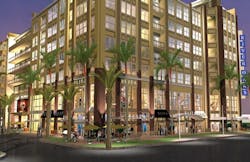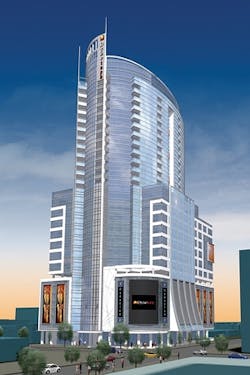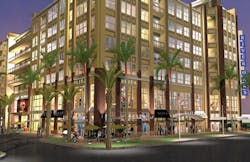The Reinvention of Mixed-Use Facilities
The last 40 years have been hard on mixed-use facilities. Going from underappreciated to exploited to ill-defined, these projects have withstood their fair share of identity crises. Despite the confusion and contention, however, mixed-use is definitely growing. Recent trends in urban revitalization, sustainable thinking, and the desire for old-school communities have allowed mixed-use to sing a new, defining song.
Segregated uses like standalone malls or apartment buildings, the norm in post-World War II U.S. building, are fast losing their appeal. The idea of live-work-play destinations, though overused in some cases, underscores the longing for a return to small-town convenience and sociability. Explains developer Mike Antonopoulos, partner with the Fernandina Beach, FL-based Amelia Park Development, "Post World War II, the trend definitely was segregated uses; before the war, you had small towns [with] an old, historic downtown where you've got a commercial area, and maybe right behind it you transition into a residential area."
Antonopoulos develops mixed-use projects with traditional neighborhoods like the Amelia Park project located in Fernandina Beach, FL, on Amelia Island, 35 minutes from Jacksonville off the northeast coast of Florida. "Now, the movement seems to be back to traditional," says Antonopoulos, who, after studying other successful mixed-use projects and communities, tapped into the old equation of pedestrian-minded town centers with a strong mix of housing, shops, and offices. The recent trends in mixed-use lean toward this small-town feel, now transplanting it into densely populated urban locations.
COURTESY OF BAKER BARRIOS ARCHITECTS
Scott Martin, associate principal at Orlando, FL-based Baker Barrios Architects, also notes the general trend in urban projects favoring mixed-use. "You're providing more choices," Martin says. "It's part of a bigger, integrated fabric of the downtown core, as opposed to being some freestanding sort of suburban, single-use development." Mixed-use projects by Baker Barrios Architects include The Plaza in downtown Orlando, which provides a major commercial, entertainment, and residential presence. The Plaza has invigorated urban activity downtown and exemplifies the impact mixed-use projects can have for urban revitalization.
"A large part of the live-work-play concept is that people know there's an energy associated with it, and they feed off that energy," says Martin. "That's what people want to be around." Mike Sullivan, principal at Memphis, TN-based Looney Ricks Kiss, senses the same energy and desire, saying, "It's really about making a place where you're able to live ... you can work, you can entertain ... it's all about, ‘How many things can I do without having to get in the car?' "
Sullivan sees the demands of the market affecting the growth of mixed-use. "As land gets more expensive and less and less available, and as municipalities take a more aggressive stance toward smart growth ... a whole lot of developers and end-users in the country are leaning more toward mixed-use," he says, also making a point to separate true mixed-use from the tagalongs and imposters riding the trend's marketing wave.
According to the Washington, D.C.-based Urban Land Institute (ULI), a true mixed-use project must have three or more significant revenue-producing uses, significant functional and physical integration of the different uses, and it must conform to a coherent plan. While this definition leaves room for interpretation, Martin adds that the uses should balance each other for the most solid mix. "It has to sort of follow the market in terms of what the mix is ... but a stronger mixed-use is where you have a more balanced approach," he says, "so you get that live-work-play aspect a bit stronger than just a little bit of retail shoved under a residential footprint."
Antonopoulos drives this idea further, listing the necessary components of life as the basis for what should comprise a mixed-use project. "People use the term ‘live-work-play' like there are only three components," he says, "but when you think about everything you need in one location, the list grows." According to Antonopoulos, housing, education, recreation, working, eating, worship, and medical care are all necessities and should, therefore, be included in (or at least near) a true live-work-play or "lifestyle" center. The convenience of having all these needs met in one location is clear, but there are also more subtle advantages.
Antonopoulos notes the impact a pedestrian-friendly mixed-use project has on the people who live there. "There's a social benefit, obviously, of people being able to walk there and interface with their neighbors," he says. "In typical subdivisions, you pull into your driveway or garage and walk in, and half the people don't even know the people that live on either side of them." Not so, he argues, in a community-focused mixed-use project like Amelia Park. "The concept here is interaction - on the sidewalk or out on a porch, you might see six or eight of your neighbors, or you go down to the restaurant or coffee shop and there's another chance for interaction." Antonopoulos adds, "Really, the production homebuilder basically focuses on where we live and what we live in, and mixed-use projects want to focus more on how we live."
STEVE HINDS PHOTOGRAPHY
The social benefits of walking segue directly into the green aspects of mixed-use projects. Relief on the transportation system, clearly, has a major impact on reducing pollution from vehicle emissions. The trend toward renovating existing downtown areas (known as "urban infill") also adds to the sustainable features of mixed-use projects: Outdated spaces are made useful again, and undeveloped land is left that way. Now, with green building on the rise and opportunities for LEED certification at every door, new construction of mixed-use facilities can be more environmentally friendly than ever before.
Interestingly, Sullivan, Martin, and Antonopoulos think that all successful and well-planned mixed-use projects are inherently sustainable because of their flexibility. "You want to make sure the bones are right," says Martin. "You want to provide flexibility that accommodates all the uses now and whatever may happen in the future as well." The market must be considered when planning the "bones" of the building, and Sullivan mentions the trend in designing buildings with "flex space" that can be adapted to different uses as demands change. "We design a building on a streetscape or in a place with a master plan that, one day, we hope will be retail, but right now, the market's not there," says Sullivan. "And, then, as the market and consumer demand grow in that location, the space changes ... it allows for the marketplace to drive the buildings' use and life-cycle, instead of allowing a building to sit empty." Ultimately, flexibility is sustainability in mixed-use.
Jenna M. Lassen ([email protected]) is new products editor at Buildings magazine.


